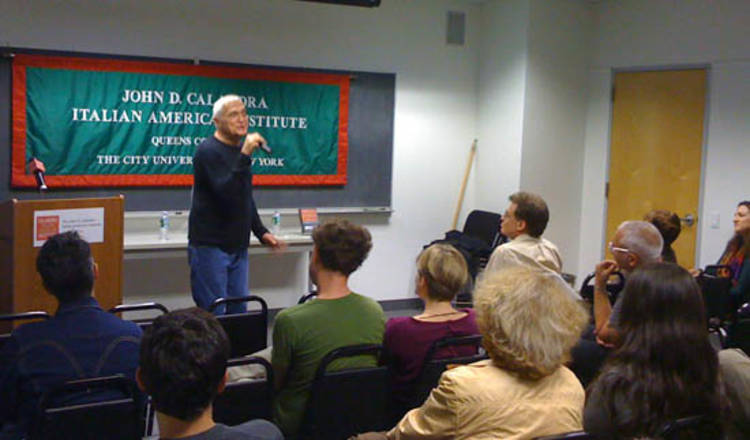


Author George De Stefano [2] began a 2001 book review in the John D. Calandra Italian American Institute’s social-science journal, the Italian American Review [3] (vol. 8, no.2), with a rhetorical question: “Who, or more precisely, what is an Italian American? To some self-appointed arbiters of italianità, the answer is: Roman Catholic, conservative, and indisputably heterosexual.” If we have learned anything from the ongoing scrutiny of the Italian-American “experience” it is that said experience is any thing but singular. Italian-American histories and cultures are diverse, multifaceted, and ever open to new interpretations and revisions. The Calandra Institute’s public programs offer an opportunity to recognize and represent the diverse expressions of an italianità alternativa.
On October 6, 2009, John Giorno [4] read from his selected works Subduing Demons in America [5] (Soft Skull Press, 2008) as part of the Institute’s Writers Read series. Giorno founded the artist collective Giorno Poetry Systems [6] in 1968, which used technology to make poetry accessible to new audiences and influenced spoken word and slam poetry. He helped pioneer the exploration of “queer” sexuality in poetry during the 1960s. His AIDS Treatment Project, begun in 1984, set the bar for direct, compassionate action in the AIDS crisis. A practicing Buddhist since the early 1970s, Giorno has been instrumental in advancing Buddhism in North America [7], and in the cross-fertilization of Buddhist and poetic practice.
Among the many poems Giorno performed at the Institute was “La Saggezza Delle Streghe (Wisdom of the Witches),” set in Castelmezzano [8], a town in Basilicata with mountain peaks resembling “big, broken, splintered teeth spiked into the sky.”
Arcade delves into the restrictive and stifling aspects of her Italian-American family in her tour-de-force “La Miseria.” Named for the extreme poverty that was the impetus for millions of Italians leaving their homes in search of work, the 1991 production centered around an Easter dinner table and involved thirty-three performers. Arcade’s family members were not “Americans” but “peasant working class Southern Italians.” As a teenager who snacked on focaccia stuffed with pickled eggplants, she realizes that she is not the “all-American girl” but the “other American girl.” When Arcade’s child-self expresses her desire to be a dancer and an actress, she is chastised for being a “puttana” (whore). Characterizing her pugnacious Basilicata immigrant mother, who makes an appearance in a projected video, as the “Marlon Brando of mothers,” Arcade acknowledges her mother’s lasting influence on her life.
Women’s sexuality and conventional roles are themes found in Arcade’s work as well as that of The World Famous Pontani Sisters [15], a dance trio at the forefront of the neo-burlesque movement [16]. This new performance genre revives older forms of popular entertainment to reframe women’s bodies within a post-feminist era. Rebecca Shapiro’s documentary film about the Pontani Sisters, Showy and 5’2”: The World Famous Pontani Sisters (2004), will be featured in the Institute’s Documented Italians film and video series on Wednesday, February 3, 2010. With their tattooed bodies and heavy makeup, the trio—third-generation Angie and Tara, and “adopted sister” Helen Burkett—combine tap, Las Vegas show-girl routines, 1960s go-go dancing, and other forms in a post-modern mélange.
The Philadelphia Weekly described The World Famous Pontani Sisters as “curvaceous punk rock Rockettes,” while the Village Voice proclaimed the group “glamorous Italian Stallions that live up to the ‘World Famous’ part of their name.” Knowledgeable about striptease’s history, they present the eroticized female body within the conventions of this historically “low art” form with an ironic sensibility.
Distinctions between low culture and high culture [17]have become increasingly blurred as various art forms borrow stylistic elements from each other. This is most evident in the shift of the lowly comic to the prestigious graphic novel. Cartoonist Mike Cavallaro [18] began working in New York City comics and animation industries in the 1990s, and is now a member of ACT-I-VATE [19], a comics collective based in Gowanus, Brooklyn. On March 18, 2010, Cavallaro will present Parade (With Fireworks) [20] (Image Comics, 2008) as part of the Writers Read series. The comic, which was nominated for the 2008 Will Eisner Comic Industry Award for Best Limited Series, is based on a family story set during the Feast of the Epiphany in 1923 Calabria. The narrative’s central conflict begins with an argument that escalates into a gunfight as a fascist shoots Vincenzo, a socialist. His brother Paolo retaliates and goes into hiding, and as a result his family faces unforeseen hardship. Parade (With Fireworks) addresses issues of loyalty and betrayal to family and country amidst a volatile political climate.

John Giorno, Penny Arcade, The World Famous Pontani Sisters, and Mike Cavallaro are among the many artists offering provocative and sometimes disconcerting readings of Italian-American experiences through the themes and genres of their work. By including the perspectives of an italianità alternativa in the Calandra Institute’s programs, we make space for the creative and intellectual engagement of identity within various Italian-American communities.
Source URL: http://ftp.iitaly.org/magazine/focus/op-eds/article/italianita-alternativa-0
Links
[1] http://ftp.iitaly.org/files/12753giorno12644503960jpg
[2] http://www.georgedestefano.com
[3] http://qcpages.qc.cuny.edu/calandra/italrev/index.html
[4] http://en.wikipedia.org/wiki/John_Giorno
[5] http://www.softskull.com/detailedbook.php?isbn=1593762046
[6] http://brainwashed.com/giorno
[7] http://books.google.com/books?id=zqG0x8NJ4l4C&pg=PA63&dq=john+giorno+buddhism&cd=1#v=onepage&q=john%20giorno%20buddhism&f=false
[8] http://en.wikipedia.org/wiki/Castelmezzano
[9] http://en.wikipedia.org/wiki/Aliano
[10] http://www.noeltanfilm.com
[11] http://www.pennyarcade.tv
[12] http://mitpress.mit.edu/catalog/item/default.asp?ttype=2&tid=11877
[13] http://www.warholstars.org/ridiculous.html
[14] http://movies.nytimes.com/movie/review?res=9D06E0DE143DEF34BC4F52DFB4668389669EDE
[15] http://www.pontanisisters.com
[16] http://www.nytimes.com/2008/05/18/nyregion/thecity/18burl.html
[17] http://www.mnstate.edu/gracyk/courses/mla%20course/mlasyllabus.htm
[18] http://www.66thousandmilesperhour.com
[19] http://www.act-i-vate.com
[20] http://www.activatecomix.com/12.comic